Greetings,
On my past article, I introduced you to the world of Kamigawa — the background of the latest Magic: the Gathering set — and how we might adapt it for an RPG campaign setting with D&D 5th Edition rules. Today, in the continuation of this work, I finally bring the characteristics and traits of the six races available to players present in the plane based on Japanese culture: humans, kitsune, soratami, nezumi, akki and orochi.
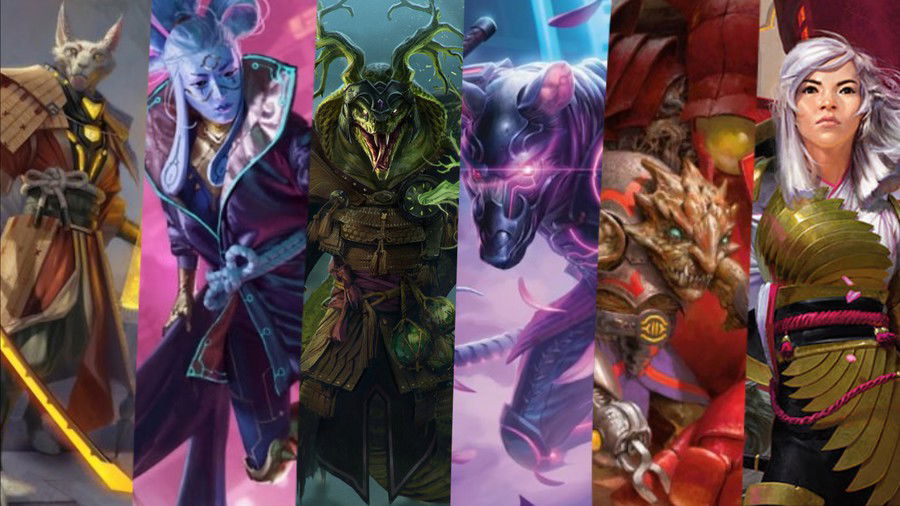
I know it's kind of obvious to say this, but it's always good to point out to leave no doubt: the content you'll find below is Homebrew; which means it didn't pass thorough a playtest. With that in mind, I've tried not to change too drastically any element inherent in the already established rules of D&D 5th Edition. All I did was adapt rules and concepts already presented in official books to the theme of the scenario in question. I've also taken the liberty of looking for references in homebrew creations by others in the community, giving credit to them whenever possible. My intention with this material is not to reinvent the system, but to offer tools to better set D&D adventures in Kamigawa or eventually in any other themed setting that mixes cyberpunk elements and Japanese culture.
Humans
As with most other worlds, humans are the dominant and most populous race on Kamigawa. Cities and human settlements can be found throughout the plane, and they often serve as centers for other races to trade and interact. The widespread nature of human settlements means that their culture is much less defined than other races, with the environment often shaping the people who live there.
It also means that humans find many paths in life. Wherever you go, you are likely to encounter humans, whether serving as a samurai for the Imperial Court in Eiganjo, studying at Minamo Academy, or living as ascetic hermits in the Jukai Forest.
Humans Representation Asari Captain, Biting-Palm Ninja, Dokuchi Silencer, Heiko Yamazaki, the General, Imperial Subduer, Isshin, Two Heavens as One, Jukai Naturalist, Jukai Preserver, Jukai Trainee, Kotose, the Silent Spider, Naomi, Pillar of Order, Raiyuu, Storm's Edge, Reinforced Ronin, Satoru Umezawa, Scrapyard Steelbreaker.
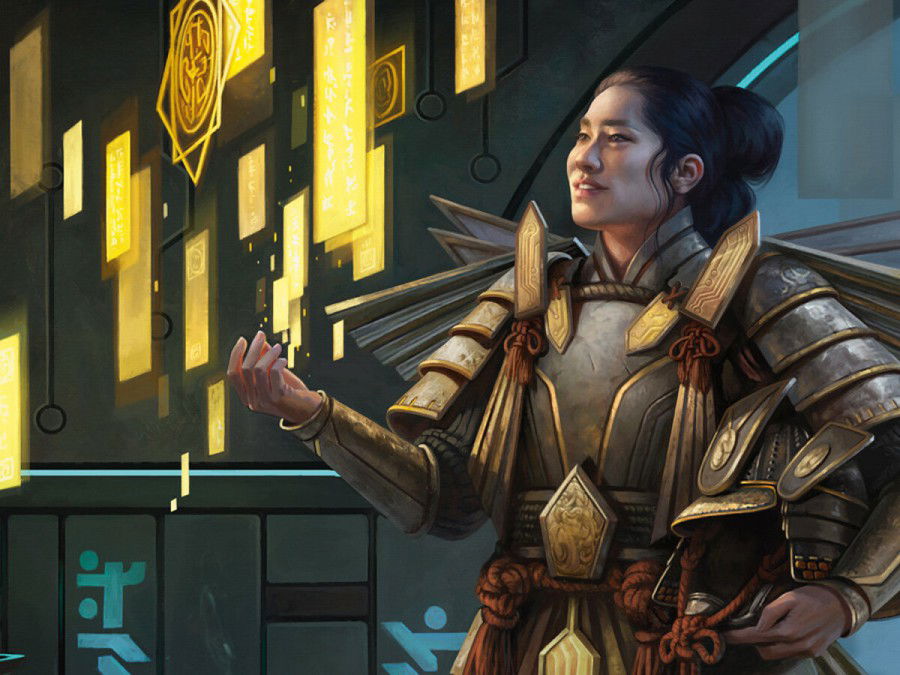
Human names
Male names: Dokai, Dosan, Godo, Kenzo, Higure, Hisoka, Homura, Isao, Iizuka, Isshin, Iwamori, Kentaro, Kumano, Nagao, Reki, Sakashima, Satoru, Tatsunari, Toshiro.
Female names: Azami, Azusa, Fumiko, Heiko, Tamoya, Kaho, Kiku, Kotose, Masako, Michiko, Naomi, Norika, Risona, Satsuki.
Surnames: Yamamoto, Saito, Yoshida, Yamazaki, Kabayashi, Konda, Murakami, Tanaka, Takeno, Takahashi, Umezawa, Susuki, Hashimoto, Shinkai.
Human Racial Traits
The humans of Kamigawa have the same racial traits as the humans described in the Players' Handbook.
Kitsune
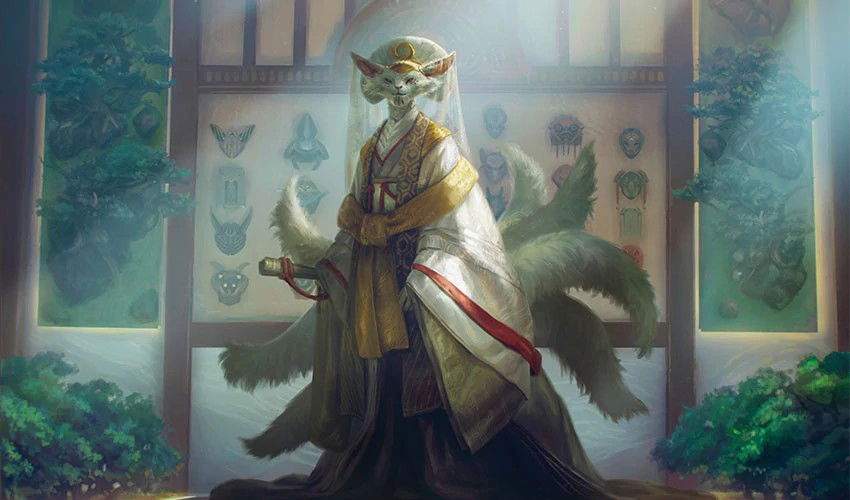
Kitsune are wise and elegant anthropomorphic foxes who hold honor in the highest regard. Unlike many other non-human races in Kamigawa, kitsune are well integrated into human society, with their forms generally considered graceful and beautiful. They do not build cities of their own, as they are relatively few in number, preferring to live in human cities or isolated monasteries. Kitsune love the arts, with many renowned poets, painters, and philosophers throughout the ages belonging to the race.
Physical Characteristics. Kitsune are agile and graceful, with long, sharp fox faces. Long, pointy ears protrude from the sides of their heads, and their mouths tend to be hidden behind their pointed noses. Their eyes are small and round and can be a variety of colors, including black, gold, and blue. They do not have hair like humans, instead they are covered in fine fur.
Its coat varies from silvery white to golden brown and rust red. They are slightly shorter than humans, ranging from around 4ft to 5ft 11in in height. Their slender frame also means they are considerably lighter than humans, weighing between 99lb and 143lb. The bodies of males and females differ only slightly.
Tails. A distinctive feature of the kitsune is their long, fluffy tails. All are born with at least one tail, but over the course of an individual's life they can grow up to nine tails. Personal accomplishments seem to be linked to the growth of additional tails. Honorable and wise kitsune have more tails and, as a result, are often seen as leaders among kitsune. Most common kitsune peasants will live their lives with just one tail, while important families will regularly have individuals with multiple tails. Very few reach more than five tails, and those that do frequently act as leaders of their people, regardless of the status of their families. Nine-tailed individuals are so rare that many consider them practically divine. There has never been more than one nine-tailed kistune at any time in recorded history.
Although the growth of tails is linked to honor and achievements, its definitions can vary between individuals. Kitsune with multiple tails aren't necessarily kind or gentle, for example. A kitsune can acquire tails by serving a lord loyally as a samurai, even if the lord is a tyrant. Likewise, those with a tail are not necessarily dishonorable, but probably simply ordinary people without great accomplishments.
Kitsune representations: Blade-Blizzard Kitsune, Golden-Tail Disciple, Hotshot Mechanic, Kitsune Ace, Light-Paws, Emperor's Voice, Mothrider Patrol, Selfless Samurai, Seven-Tail Mentor.
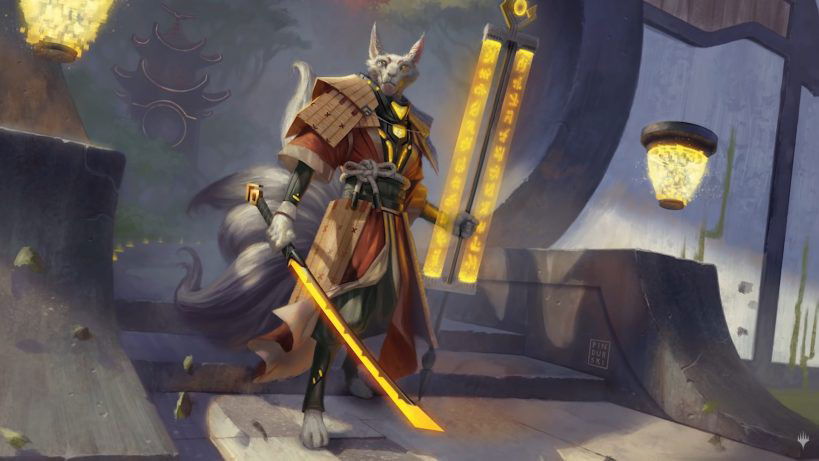
Kitsune names
Kitsune have a very characteristic way of choosing their names. They commonly select names that describe striking physical features, such as Golden-Eyes, Sharp-Fang, or Light-Paws. However, these compound names are never just literal, but also represent something abstract or subjective regarding the kitsune's personality. Some also add adjectives that indicate their qualities or perception of the world. Humility, however, is considered when a kitsune selects their names. Arrogant names are frowned upon by other individuals of the race. Likewise, name changes should only accompany major accomplishments or events, as frequent name changes are seen as boastful. As a result, kitsune names tend to be based on their physical characteristics, whether poetic or literal, or linked to their profession.
Kitsune Names: Winter-Paws, Pearl-Eyes, Sage Snout, Clay-Foot, Iron-Claw, Silver-Blade, Moon-Skin, Golden-Tail, Half-Ear, Silent-Fang, Sickle-Nose, White-Tail, Onyx-Eyes, Swift-Arm.
Kitsune Racial Traits
Kitsune possess the following racial traits.
Ability value increase. Your Charisma increases by 2, and your value in another ability of your choice between Dexterity or Knowledge increases by 1.
Age. A kitsune reaches adulthood after age 20. A typical member of the breed lives about 100 years, plus another 100 years for each tail it has, up to a maximum of 1000 years. These numbers are actually estimates. As very few kitsune acquire more than 6 tails, it is difficult to be sure about the actual lifespan of the breed. Some believe that a kitsune effectively becomes immortal after reaching the ninth tail.
Alignment. Kitsune value tradition and honor, and therefore tend to fall on the Lawful side of alignment. Most kitsune are also bred to act honorably, though these codes of honor don't always translate into good and kind individuals.
Size. Kitsune are 4ft to 5ft 11in tall with agile bodies. Their sizes are medium.
Speed. Your base ground speed is 30 feet.
Darkvision. You can see in dim light up to 60 feet away from you as bright light, and in darkness as dim light. You cannot discern colors in the darkness, only shades of gray.
Heightened Senses. Much like the foxes they resemble, kitsune have heightened senses. You are proficient in the Perception skill.
Calm mind. You have advantage on saving throws against being charmed.
Flawless form. When you would make one weapon attack with advantage, you can make two attacks with no advantage. You cannot use this feature again until you finish a short rest.
Fox Tails. You are born with 1 of your potential 9 tails, and they are an extension of you. The Kitsune's tail is an important extension of its body. You can perform the somatic gestures for spells with your tails. If a spell requires a somatic component, the kitsune must have free use of their tails or at least one hand to perform the gestures. The new tails grow at the DM's discretion as you level up, as shown in the table below. Events such as saving lives, attaining spiritual enlightenment, or overcoming personal demons may cause additional tails to grow at the DM's discretion. The growth of a tail occurs during a long rest shortly after the event, and you are immediately aware of it upon awakening.
| Level | Number of Tails |
|---|---|
| 1 | 1st Tail |
| 3 | 2nd Tail |
| 5 | 3rd Tail |
| 7 | 4th Tail |
| 9 | 5th Tail |
| 11 | 6th Tail |
| 14 | 7th Tail |
| 17 | 8th Tail |
| 20 | 9th Tail |
Also, tails can be cut off/removed due to injuries. Losing your tails reduces the amount of times you can use abilities associated with your tails, but not your aging. They can be regenerated through magic.
Languages. You can speak, read and write Common and Sylvan.
Soratami
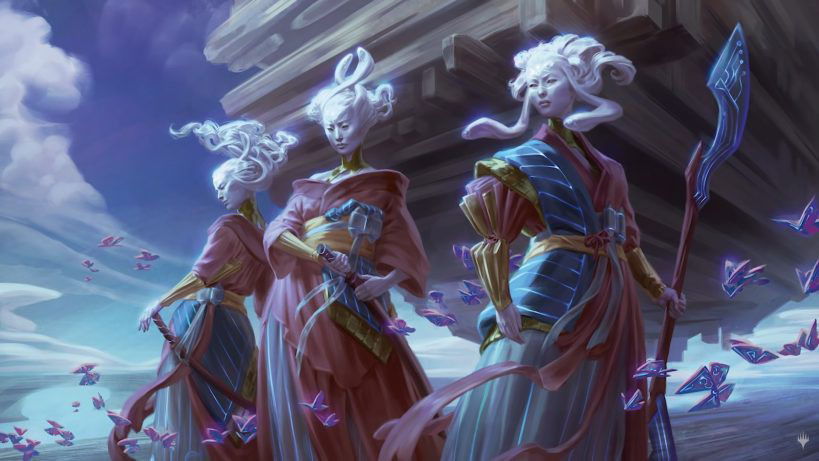
The soratami, also known as the moonfolk, are a race of enigmatic beings that inhabit the clouds of Kamigawa. They claim to be descendants of a powerful moon kami, hence the name of the race. Soratami live within floating cities, the largest and best known of which is Otawara, Soaring City. Members of the race have a strong emphasis on the study of magic, which makes for some of the most learned wizards on the plane to be among them. This affinity for arcane magic meant that the moonfolk were always at the forefront of Kamigawa's technological evolution. The technocratic faction of the Saiba Futurists is primarily run by soratami. They don't have the natural ability to fly, but they always have spells that grant them that ability.
Physical Characteristics. Soratami are slender creatures, with an elf-like stature. They have white or whitish fur, usually a very light blue or bluish-gray. They have long flowing hair, the same color as their skin, which is commonly tied up in elaborate hairstyles. Soratami comes with a distinct feature: their two long rabbit ears that fall to their shoulders. They typically have some sort of ornate mark on their face (typically extending from their forehead) and ears. Some Soratami still have these marks along their body. They often wear long, flowing, kimono-style dresses that seem to float around them, adding to their elegance.
Enigmatic and distant nature. Soratami are an isolationist society, with a penchant for being snobbish, who live in cities and palaces in the clouds. These properties roam the skies far above the surface. Their connection to the sky and heights makes many Soratami master the innate ability to fly, or become interested in piloting vehicles, aircraft, and other flying vehicles such as Mechs. Still, moonfolk can be found living in almost every sector of the Towashi metropolis, where their talents in arcane magic and technology are of great value. They care deeply about their families and their people, and most of the decisions they make are for the betterment of themselves, so they can be very selfish and arrogant at times. Soratami pride themselves on their knowledge and intellect; however, many can be capable warriors and skilled in combat.
Soratami Representations: Guardians of Oboro, Katsumasa, the Animator, Kotori, Pilot Prodigy, Moonfolk Puzzlemaker, Network Disruptor, Replication Specialist, Research Thief, Saiba Trespassers, Tameshi, Reality Architect.
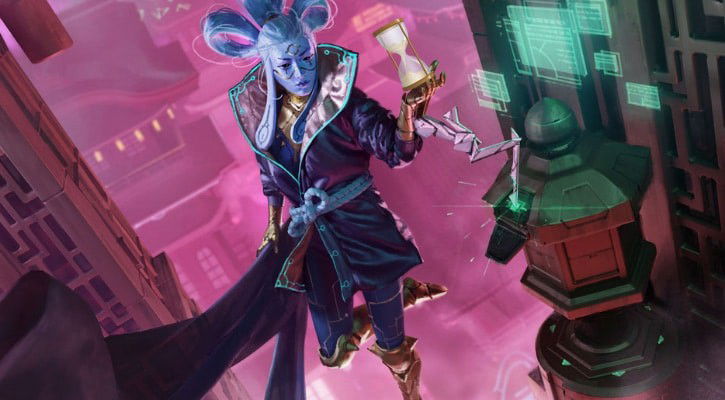
Soratami names
Due to their reserved nature, Soratami are not often named after other races. Here are some common Soratami names:
Female Soratami names: Akiyo, Chiyo, Haruyo, Kazuyo, Mitsuyo, Noriyo, Tamiyo, Uyo, Erayo, Kotori.
Male Soratami names: Dairoku, Eitoku, Gaku, Kensaku, Meloku, Riku, Shusaku, Taku, Tameshi, Katsumasa.
Soratami Racial Traits
The Soratami possess the following racial traits:
Ability point increase. Your Intelligence is increased by 2, and your score in another skill of your choice between Knowledge or Charisma increases by 1.
Age. Soratami reach maturity around age 20 and can live from 200 to 250 years.
Alignment. Most Soratami are commonly of Lawful or Neutral alignments.
Size. Soratamis are between 4ft to 5ft 11in tall. Their sizes are medium.
Speed. Your base walking speed is 30 feet.
Darkvision. Used to observing under the night sky, you have superior vision in dark conditions. You can see in the dim light up to 60 feet away from you as if it were bright light, and in the darkness as if it were dim light. You cannot discern colors in the darkness, only shades of blue.
Feather Fall. Soratami have a great affinity for gravitational manipulation magic, which allows them to levitate gracefully when in free fall. This ability works like the feather fall spell, but only affects soratami. You can activate it with no daily limit using your reaction.
Arcane Studies. Choose a 1st-level spell with the ritual tag from the wizard spell list. You can cast this spell as a ritual. You also know a cantrip of your choice from the wizard spell list. Intelligence is your spellcasting ability for these spells.
Enlightenment. You have proficiency in one of the following skills of your choice: Arcana, History, Insight, Investigation, Medicine, or Perception.
Languages. You can read, write and speak Common, Soratami and a language of your choice.
New Talent: Lunar Blessing
Prerequisite: Soratami
As a soratami grows, its innate powers grow with it. You gain the following benefits:
— You gain a flying speed of 39ft. To use this speed, you cannot wear heavy armor.
— When in direct moonlight, your flight speed increases by 10 feet.
- Your darkvision doesn't have maximum range while you or whatever you're attempting to perceive is out in the moonlight.
Nezumi
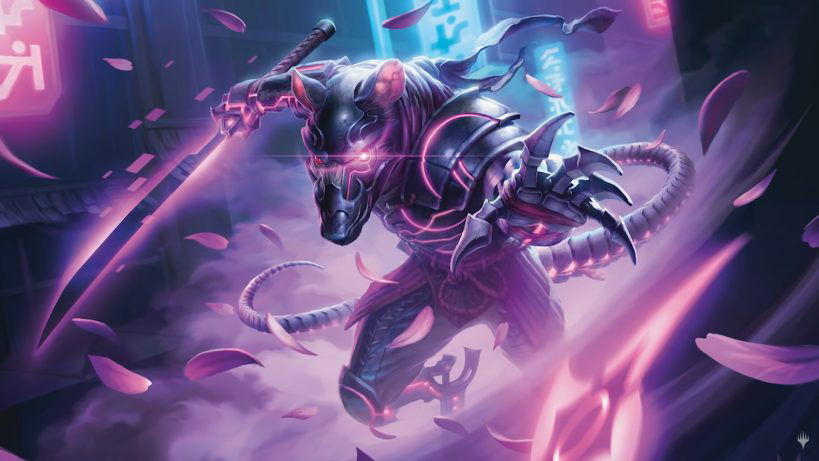
Nezumi are a race of anthropomorphic rats that generally live on the fringes of society. Nezumi almost invariably arouse suspicion and distrust wherever they go. They are mostly seen as thieves and criminals, and not without reason. Their former home in the swamps of Takenuma was a treacherous place fraught with great danger—as a result, the nezumi developed a culture where survival is the only goal. This conflicts with the codes of honor held in high esteem by many humans and kitsune, as to the nezumi they are luxuries they cannot afford. Organized in gangs, the nezumi have spread across the world, often living among the poor and destitute. They are especially prolific in the Towashi Undercity.
Physical Characteristics. Nezumi has slightly curved torsos with mouse heads and a long tail. A notable difference between nezumi and humans is the legs, which in the case of nezumi are digitigrade, resting on the toes rather than the soles of the feet. Nezumi frequently have sloppy forms, though this is usually a result of habit, caused by constant crouching in hiding. They are covered in thick fur, typically in shades of gray, brown, or black. Nezumi females can grow longer hair on their heads, like human hair, in the same color as their skin. Nezumi eyes are usually yellow, brown, black, and dull red. They are also more likely than other races to develop albinism, which results in white-skinned individuals with glowing red eyes.
Nezumi are taller than humans, however, their tendency to stoop makes them appear roughly equal in height. Their physical build is similar to that of humans under normal circumstances, but their skeletal structure is such that they can contort their bodies, allowing them to squeeze into smaller spaces easily. Like mice, their front teeth continue to grow, and they often gnaw on various hard materials to wear down their teeth.
Street Survivors. The Nezumi do not possess what others would consider culture, instead what they share is a strong instinct for survival, allowing them to adapt easily to any environment. They frequently organize themselves in the form of gangs, with loose structures at best. Nezumi are instinctively social, looking to groups for protection and security.
The nezumi's exact social conduct varies according to the gang they are a part of. Some gangs are ruthless and cruel places where members regularly rob and cheat on each other, and promotions are usually gained by killing their superiors. Some gangs are more organized, others even have codified rules of conduct. More organized gangs tend to be rarer and fewer in numbers, although they tend to last much longer than more undisciplined gangs. Most gangs are led by a boss, a nezumi more ruthless and cunning than the rest, who commands respect or fear from the rest of the nezumi. The boss's personality has a direct effect on what kind of gang it is.
Nezumi representations: Greasefang, Okiba Boss, Mukotai Ambusher, Nashi, Moon Sage's Scion, Nezumi Bladeblesser, Nezumi Prowler, Okiba Reckoner Raid, Silver-Fur Master.
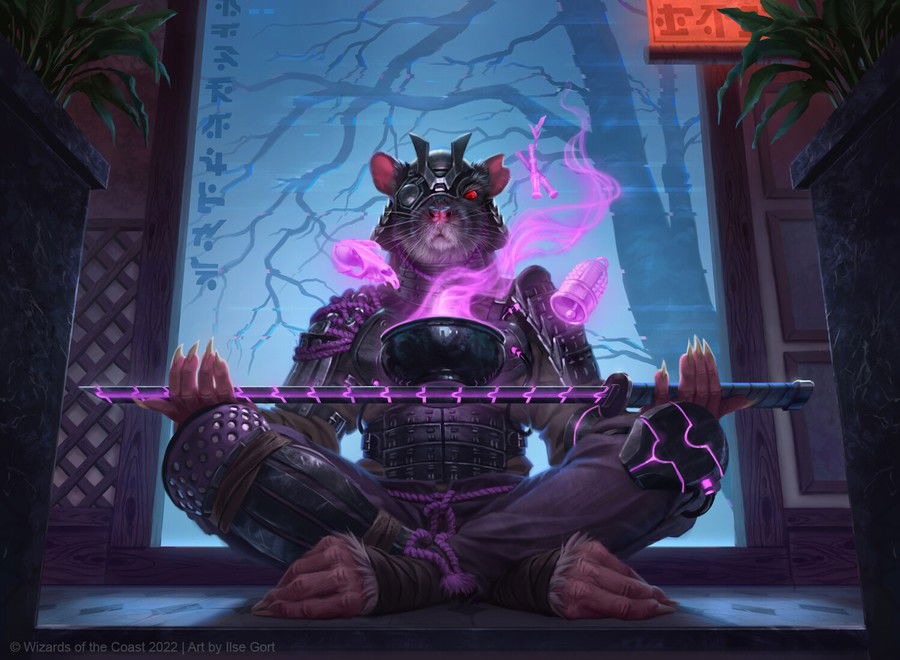
Nezumi names
Nezumi are rarely given a name at birth, as most are expected not to survive long. As a result, a nezumi's name is typically some sort of description for their physical or behavioral characteristics (similarly to kitsune), given to them as they develop to identify them, such as nicknames. As a result, nezumi names are quite fluid and distinguish little between genders. Some nezumi choose to continue using previous nicknames, while others decide their own name. Additionally, individuals of the race can often have human-like names if they live in human-dominated regions.
Names: Short Tail, Three Legs, Swamp Snout, Fine Bones, Six Fingers, Rusty Blade, Ink-Eyes, Marrow-Gnawer, Night-Eyes.
Nezumi Racial Traits
Nezumi possess the following racial traits:
Ability value increase. Your Dexterity increases by 2 and your Constitution increases by 1.
Age. The Nezumi reach physical maturity towards the end of their first decade. A nezumi's lifespan can be up to 100 years, although nezumi over 50 are considered old, as their lives tend to be short and violent.
Alignment. Nezumi tend not to be Lawful, following their own survival instincts rather than any honor code, though some can show remarkable discipline. Selfless nezumi are also rare, though this is not the result of innate inclinations but a life of distrust.
Size. Standing, nezumi average overall height of about 6ft 2.8in tall, although many slouch to about 5ft 11in. Their size is medium.
Speed. Your base walking speed is 30 feet.
Darkvision. Coming from the dark alleys of Towashi Undercity, your eyes adapted to the darkness. You can see in the dim light up to 60 feet away from you as if it were bright light, and in the darkness as if it were dim light. You cannot discern colors in the darkness, only shades of gray.
Nezumi Resilience. You have advantage on resistance tests against poison and have resistance against poison damage.
Shadow Skulker. You can try to hide even when you are only slightly obscured by dim lighting.
Contortion. You can move at your base walking speed by squeezing yourself into a space large enough for a creature up to one size category smaller than you. You can only use this feature when you are in your normal form.
Artisan Specialty. You gain proficiency in two types of artisan tools of your choice. Double your proficiency bonus on any skill checks you make using any of the chosen tools.
Strong stomach. You can't get illness from the food you eat. Add your proficiency bonus to tests against disease.
Survival instinct. Whenever you make a Dexterity ward against a trap or natural hazard, add your proficiency to the test, if you are already proficient with Dexterity ward, you can add double your proficiency instead of your normal proficiency.
Akki [Goblin]

Kamigawa goblins, called Akki, are small, curved creatures with hard, pointed shells on their backs, similar to turtles. Among other races, they have a reputation for being violent, mischievous, resourceful, and creative. Akki pranks are known to wreak havoc and destruction, whether intentional or not. However, their improvised contraptions are also largely copied by other creatures, although they are usually refined for safer use.
Akki tend to live in cave communities in the Sokenzan Mountains, where they cooperate with the humans of Sokenzan-shi and other communities, primarily in smithies and industry. They have a strong natural curiosity, although their complete lack of security in most of their experiences means that akki tend to lead short lives.
Physical Characteristics. Akki are small, hunched creatures with monstrous features and a hard shell on their backs. They have long pointed noses, small eyes, lots of sharp teeth and no visible ears. Two small horns protrude from their forehead. Their eyes tend to be blue or green, contrasting with their leathery skin that often ranges from crimson to earthy brown. Their bodies are large for their size, and their arms are long and slender, with long clawed fingers used for digging. Their bodies are entirely hairless, as these things would only be a disadvantage when exposed to fire.
The most distinguishing feature of the akki from the goblins of other worlds is the shell that covers their back. They are covered in spikes and appear to be the same color as their skin. Akki shells are exceptionally hard and heat-resistant, which is essential for allowing akki to survive everyday life. Their skin is also much tougher than that of other races.
Mountain culture. Akki culture varies greatly from one community to another, although they share some similarities. Most akki live in large cave complexes as part of a tribe. Each tribe often lived in the same caves for generations. These cave structures, a combination of natural tunnels and generations of excavations, often go deeper into the mountains, often connecting to pools of magma that are used to heat the tunnels and supply the boilers and smelters with thermal energy.
Akki representations: Akki Battle Squad, Akki Ember-Keeper, Akki Ronin, Enthusiastic Mechanaut, Fable of the Mirror-Breaker, Goro-Goro, Disciple of Ryusei, Scrap Welder, Sokenzan Smelter, Twinshot Sniper.
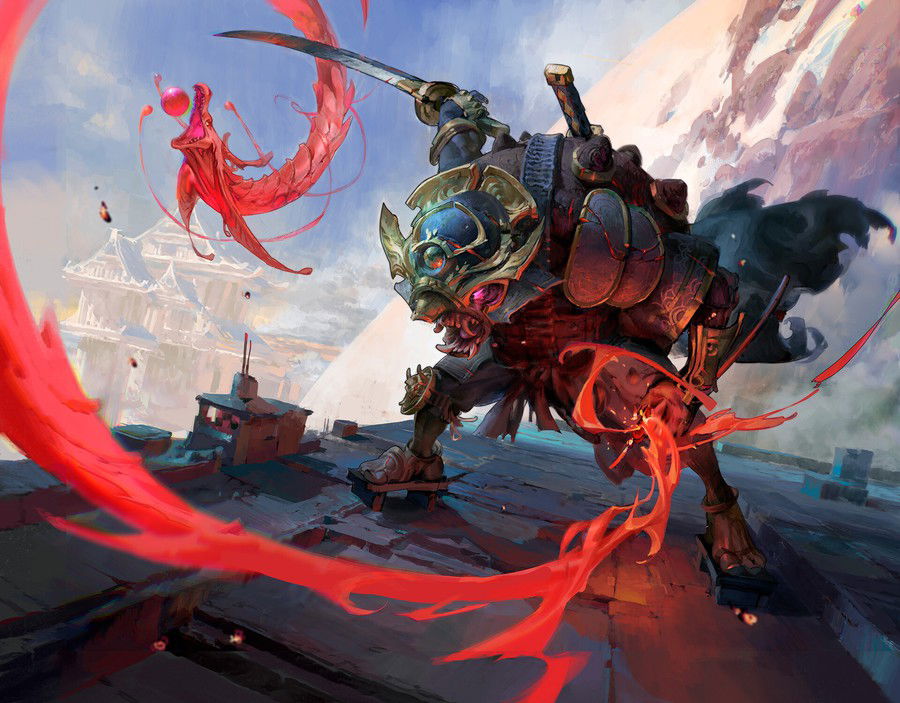
Akki names
The Akki language loves certain sounds, and goblin names tend to repeat syllables that produce those sounds to form compound names that look like onomatopoeia.
Akki names: Tok-Tok, Ben-Ben, Goro-Goro, Ishi-Ishi, Kiki-Jiki, Zo-Zu.
Akki Racial Traits
Akki goblins have the following racial traits:
Increase in Attribute: Your Constitution increases by 2 and your Dexterity increases by 1.
Age. Akki reach adulthood around age 8. They age noticeably faster than humans, and while few goblins live to old age, the most cautious ones rarely live past 60 years.
Alignment. Most of Kamigawa's goblins are Chaotic, with no inclination for good or evil.
Size. Akki are around 2ft 11in tall. Despite their stature, they actually have a surprising weight, usually ranging from 66lb to 77lb. Their size is Small.
Speed. Your base walking speed is 30 feet.
Darkvision. You can see in low light up to 60 feet from you as if it were a bright light, and in the dark as if it were in low light. You cannot discern colors in the darkness, only shades of gray.
Natural Armor. You have a thick, spiked shell that grants you natural armor. When not wearing armor, your AC is 16. You can use your natural armor to determine your AC instead of armor, if the armor you are wearing makes your AC lower than your natural armor. Shield benefits apply as normal while you are wearing your natural armor.
Akki resistance. Your hull also offers protection from the heat. You have resistance to fire damage.
Languages. You can speak, read and write in Common and Goblin.
Orochi
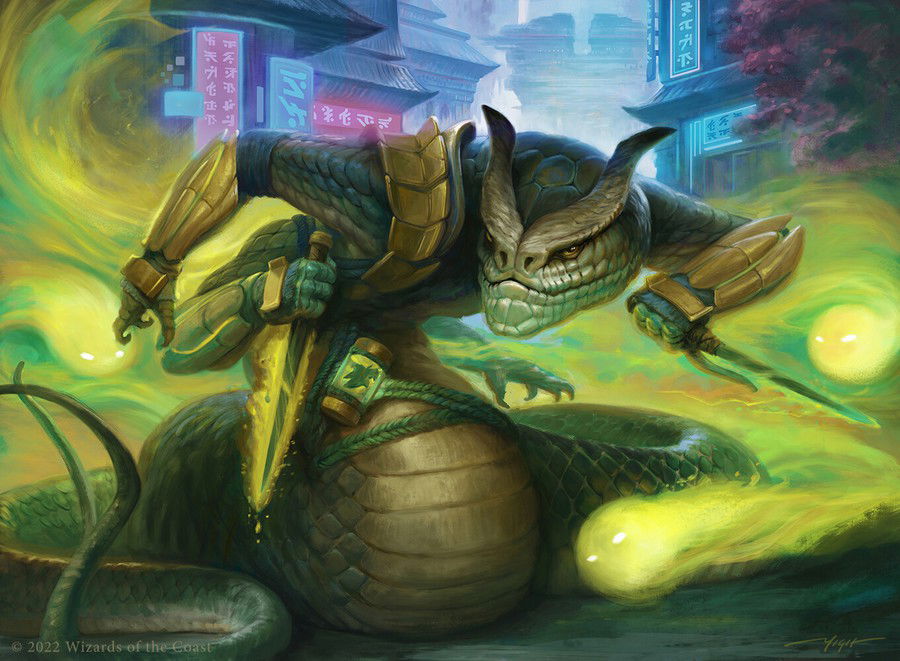
Orochi are an enigmatic serpentine race that lives in the Jukai Woods, far from the other races of Kamigawa. For centuries, they lived far from the rest of the world, fending off or killing invaders. Very few people have ever seen orochi and their reptilian features look incredibly strange to the rest of Kamigawa. They live in a unified tribal society, living harmonizing with the forest and the kami that inhabit it, being one of the main races of the Jukai Order. The Orochi are taught to revere the kami, and their connection to spirits is beyond that of the kitsune.
Physical Characteristics: Orochi have lean, but well-muscled physiques. They have four humanoid arms with each hand having three fingers and a thumb, which protrude from a slender snake-like body. Their secondary arms, located below the primary arms, are noticeably thinner than the upper arms and not as strong, although they are equally dexterous.
Their skin is covered in scales that can vary greatly, with shades of green, brown and yellow being the most common. These scales can also have patterns, although most are subtle to allow them to blend into the trees in the forest. Orochi eyes are similar to snakes, with vertical slits for the pupils and are usually brightly colored, with shades of green, blue, gold and red. From the top of their heads, two horns protrude that twist into shapes that varies with each of them.
Poison: All orochis produce venom from their fangs. The venom is not lethal to animals larger than a rabbit, but it has a disorienting effect on larger creatures. This poison can be extracted and applied to weapons, although storing the poison is largely useless, as its potency once outside the orochi's body only lasts for half a day or so. Naturally, orochi are immune to their own poison.
Touched by the Kirin. For centuries, the orochi led their lives harmonizing with the kami of the forest. However, the construction of the city of Towashi and the destruction of the forest that accompanied it infuriated the kami. They drove out all who lived within their borders and closed the forest to everyone — including the Orochi. Unable to adapt to the technological revolution wrought by the akki and moonfolk, the orochi sought reconciliation with the kami again, and in the end it was the kirin spirits who responded.
The orochi could regain their power, but they had to prove their will and sacrifice to the kami of the forest first: giving up their legs and arms and assuming an almost full snake form. Touched by their devotion, the forest kami bestowed upon the orochi greater magnitudes of power than they ever had before, and instead of simply taking all their limbs, they bestowed upon the orochi a new form—the one they currently possess, snake-bodied, but with four arms — to help them better channel that power. Orochi magic is therefore heavily based on reverence for the kami of the land itself and is visibly tied to the seasons.
Orochi Representations: Bamboo Grove Archer, Chishiro, the Shattered Blade, Coiling Stalker, Fang of Shigeki, Heir of the Ancient Fang, Orochi Merge-Keeper, Sakura-Tribe Elder, Shigeki, Jukai Visionary, Weaver of Harmony.
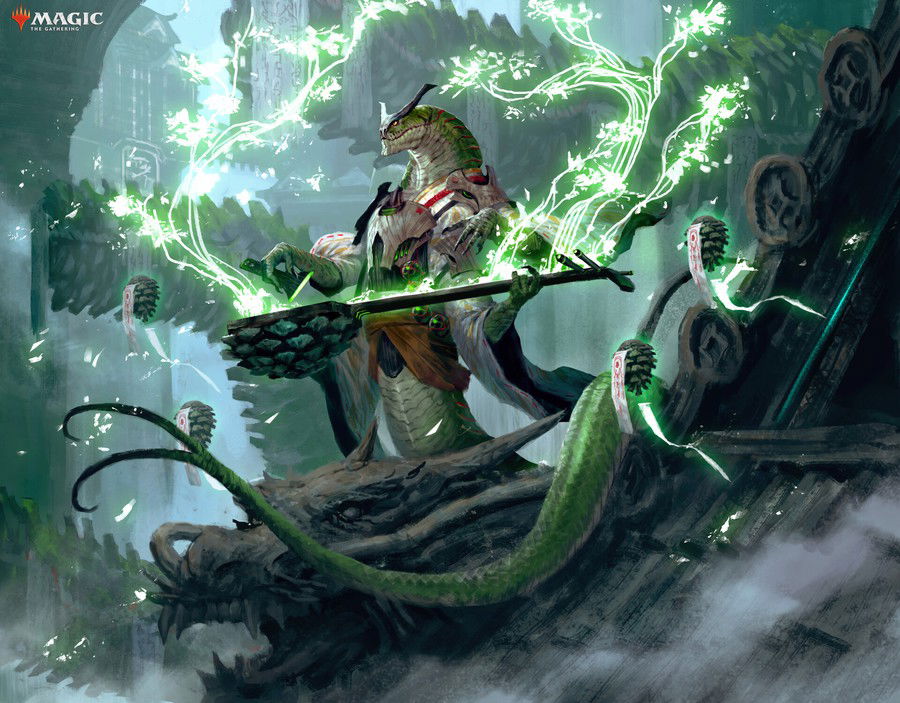
Orochi names
The Orochi only have one name, as the Orochi see themselves as family and therefore see little reason for family names. Orochi can use titles to further identify themselves, usually their tribe, position, or country. Nicknames are also commonly given by people of a tribe, and some use these nicknames as part of their name to distinguish themselves. Orochi names almost invariably begin with 's' or 'sh' sounds, which the Orochi pronounce as a whistle. Other than that, orochi names can vary greatly.
Male Names: Saburo, Chishiro, Shinobu, Shirou, Sukiro, Shigeki, Seshiro.
Female Names: Sakiko, Setsuko, Shiori, Shizuka, Sumiko, Shidako, Sachi,
Orochi Racial Traits
Orochi possess the following racial traits.
Increase in ability: Your Dexterity increases by 2, and your Wisdom increases by 1.
Age. The Orochi reach physical maturity around age 13, but are generally not considered an adult until proven themselves, usually at 16 or older. Orochi usually reach the age of 90, with a rare few reaching 100.
Alignment. Their proximity to the Kamigawa nature cycle causes the orochi to normally lean towards neutrality, without any strong penchant for chaos or order.
Size. Orochi tend to be between 3ft to 6ft 6.7in tall when erect, but their body length counting the part of the trailing tail can reach 8ft. Their size is medium.
Speed. Your base walking speed is 30 feet.
Four Arms. You have four arms. The lower pair of arms are secondary and lack the strength of the primary arms, although they are equally skilled. They are capable of carrying and interacting with objects, including manipulating and making somatic or material components and unsheathing, switching, or reloading weapons, but their ability to attack or grapple with them is less effective. Secondary arms function like your primary arms, with the following exceptions: 1) You can use a secondary arm to wield a weapon that has the light property, but you cannot use a secondary arm to wield another type of weapon. 2) You cannot wield a shield with a secondary arm.
Poison Bite. Your jagged jaw and constricting tail are natural weapons, which you can use to deliver unarmed attacks. If you hit an attack with your bite, it deals 1d4 +Strength mod. piercing damage. The creature hit by the bite is affected by your poison and must make a Constitution saving throw, the DC equals 8 + your proficiency + your Constitution modifier, or it is poisoned for 1 minute, the target can repeat the roll at the end of each of their turns, ending the effect on a successful roll.
You can use an action to coat a weapon or three pieces of ammunition with this poison by dripping it from your fangs, the poison retains its potency for 1 minute. The number of doses of this poison available is equal to your Constitution modifier with a minimum of one, after which you must take a long rest to replenish your poison. If you land a tail constriction attack, you deal 1d6+mod. bashing damage and the target is grappled (DC 8 + proficiency bonus+Strength mod). As long as it remains grappled, the creature is restrained, and you can't constrict another target.
Natural Grip. You have advantage on Dexterity (Acrobatics) checks to avoid falling onto a slippery surface.
Jungle Mask. You have advantage on saving throws you make against poisons. You also have resistance to poison damage. Orochi are also immune to their own venom (but not to the venom of other orochi).
Languages. You can speak Common, Orochi and Sylvan. The Orochi language contains many specific terms for natural things and events, such as different types of leaves or certain times during the seasons.
Conclusion
With that, we conclude one more stage of this adaptation of Kamigawa: Neon Dynasty for Dungeons & Dragons. This second part was particularly more laborious than the first, as in numerous instances it was really necessary to create new breeds from scratch. Fortunately, there was plenty of homebrew material on the internet that I could use as a reference (the main ones are listed below).
I've attempted to keep the races as balanced as possible, but as I haven't tested them in game, so it's hard to say for sure. That's why your opinion is essential. What did you think of the adaptations? Would anything change? If yes, what? Leave your comment below, your feedback can be useful for any DM that wants to use these races in their game, besides being very important to us at Cards Realm!
Rememberthat there is much more about this scenario that deserves to be considered when adapting it for D&D, such as the background, monsters and factions active in the scenario (Imperial Court, Saiba Futurists, Ryozan Punishers, etc). Perhaps I can even address these other aspects of Kamigawa in a part 3 of this series. But that depends on your interest (so comment if you want a sequel).
References
— The guidelines for adapting magic items were based on the same ones found in Plane Shift: Kaladesh by James Wyatt, with some changes by me.
— The descriptions and traits of the kitsune, orochi, and akki races were based partially on information found here, with my changes.
— The racial traits of the Soratami are based on the homebrew of reddit user u/Offbeat-Pixel.

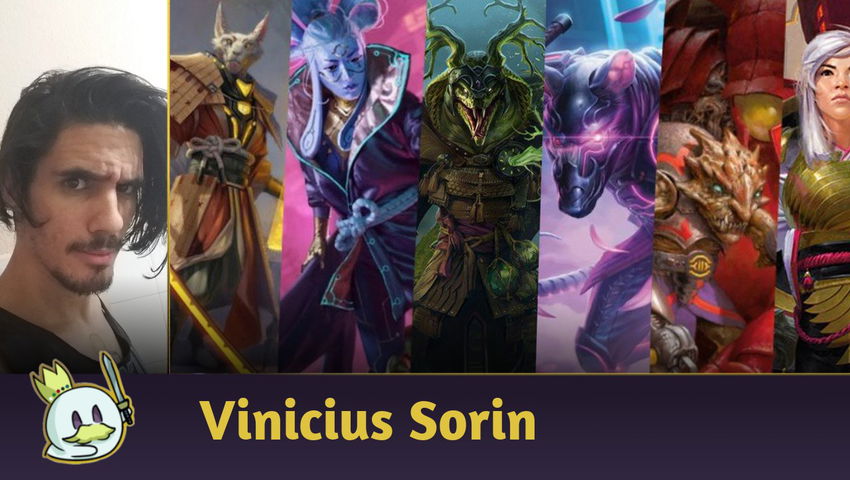







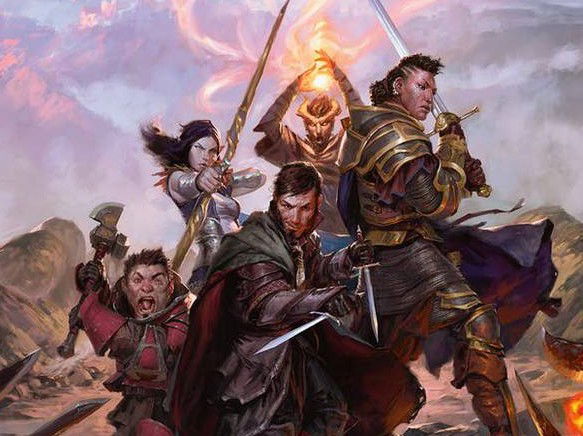
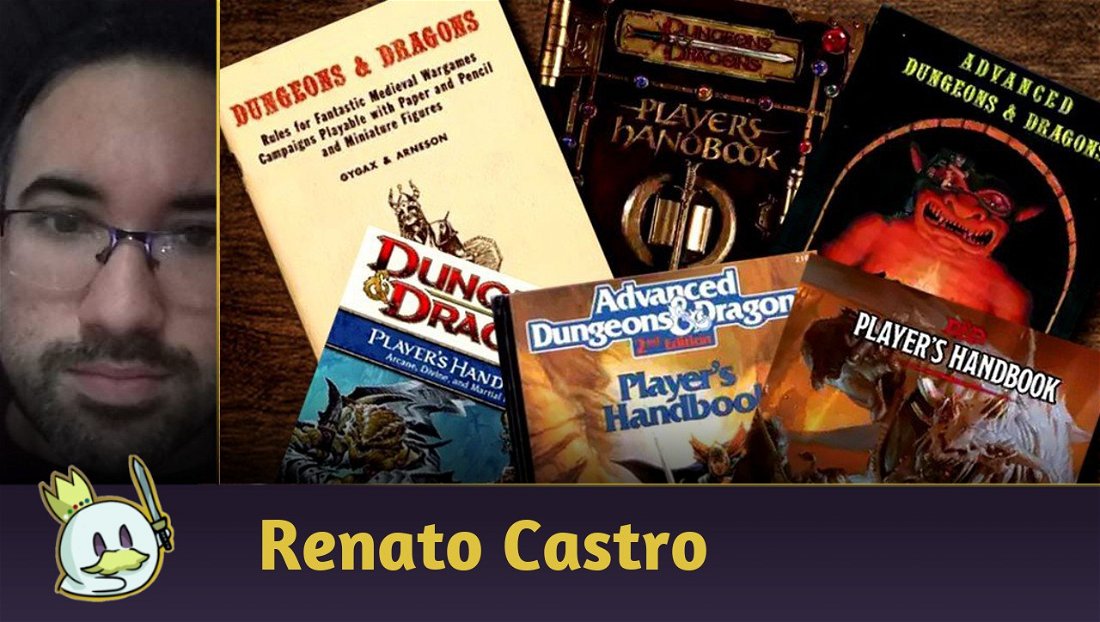



— 评论 0
, 反应 1
成为第一个发表评论的人